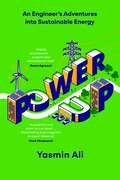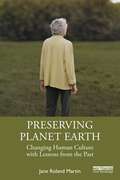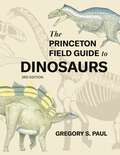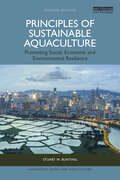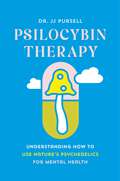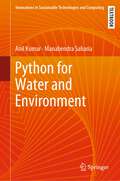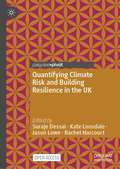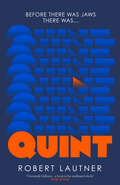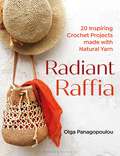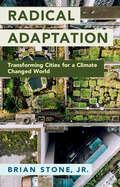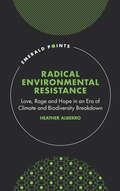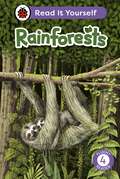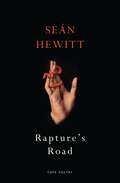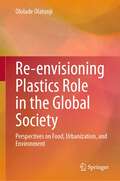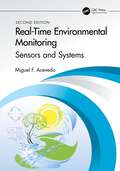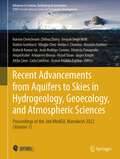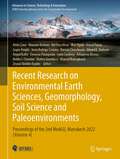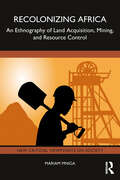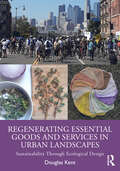- Table View
- List View
Power Up: An Engineer's Adventures into Sustainable Energy
by Yasmin Ali'A stimulating and affable overview of how major feats of engineering can help the world beat the climate crisis'NEW STATESMAN'A powerful and often lyrical book ... Fascinating and insightful in equal measure'MARK MIODOWNIK'Ali's enthusiasm for energy infrastructure electrifies this engaging tour of the people and structures that power our modern world'GAIA VINCE'Highly recommend ... a warm and educational read'ROMA AGRAWAL__________We rarely think about the energy systems that prop up our existence. With hot water, lighting and digital entertainment all available at the flick of a switch, it's easy to underestimate the vast global network that makes these things possible.Growing up in Iraq, Yasmin Ali regularly experienced power cuts - ironic for a country rich in oil and sunshine. Now as an engineer working in energy, Yasmin has a deep appreciation for what these resources mean for our lives. In Power Up she takes us on a journey across the globe to reveal the bigger picture, from solar farms shimmering in the desert to power stations hidden deep in the mountains. We discover where we get energy from, how it is moved and used around the world - and why we need to understand the whole system if we want to transition towards a clean, green future.Power Up is a definitive picture of the intricate world that humanity has built, and a rallying cry to face the challenges of climate change using the power at our fingertips.
Preserving Planet Earth: Changing Human Culture with Lessons from the Past
by Jane Roland MartinThis book encourages readers to acknowledge humanity’s contribution to the environmental crisis, proposing a way forward by exploring the power of ordinary people to bring about large-scale cultural change.Is it possible for humankind to change its ways and shed the belief that the planet is ours to do with as we like? Internationally acclaimed philosopher of education Jane Roland Martin argues that "humancentrism" is a learned affair, and what is learned can be unlearned. Turning to the past to see how large-scale cultural change has occurred, she discovers a pattern in the achievements of such historical luminaries as Martin Luther, Mahatma Gandhi, Rosa Parks and Greta Thunberg that we too can follow. Drawing on history, philosophy, and literature as well as the natural and social sciences and hoping to mobilize readers to effective action, Martin employs an accessible and powerful rhetoric, with each chapter beginning with a scene from history written in dialogue form.This book calls on young and old to avert a looming tragedy of Aristotelian proportions--the demise of the “Mother Nature” that made it possible for our species to flourish. Thoroughly interdisciplinary in its approach, it will appeal to students and teachers as well as general readers interested in environmental studies, philosophy, and education.
Preserving Planet Earth: Changing Human Culture with Lessons from the Past
by Jane Roland MartinThis book encourages readers to acknowledge humanity’s contribution to the environmental crisis, proposing a way forward by exploring the power of ordinary people to bring about large-scale cultural change.Is it possible for humankind to change its ways and shed the belief that the planet is ours to do with as we like? Internationally acclaimed philosopher of education Jane Roland Martin argues that "humancentrism" is a learned affair, and what is learned can be unlearned. Turning to the past to see how large-scale cultural change has occurred, she discovers a pattern in the achievements of such historical luminaries as Martin Luther, Mahatma Gandhi, Rosa Parks and Greta Thunberg that we too can follow. Drawing on history, philosophy, and literature as well as the natural and social sciences and hoping to mobilize readers to effective action, Martin employs an accessible and powerful rhetoric, with each chapter beginning with a scene from history written in dialogue form.This book calls on young and old to avert a looming tragedy of Aristotelian proportions--the demise of the “Mother Nature” that made it possible for our species to flourish. Thoroughly interdisciplinary in its approach, it will appeal to students and teachers as well as general readers interested in environmental studies, philosophy, and education.
The Princeton Field Guide to Dinosaurs Third Edition (Princeton Field Guides #69)
by Gregory S. PaulA fully updated and expanded edition of the acclaimed, bestselling dinosaur field guideThe bestselling Princeton Field Guide to Dinosaurs remains the must-have book for anyone who loves dinosaurs, from amateur enthusiasts to professional paleontologists. Now extensively revised and expanded, this dazzlingly illustrated large-format edition features nearly 100 new dinosaur species and hundreds of new and updated illustrations, bringing readers up to the minute on the latest discoveries and research that are radically transforming what we know about dinosaurs and their world.Written and illustrated by acclaimed dinosaur expert Gregory Paul, this stunningly beautiful book includes detailed species accounts of all the major dinosaur groups as well as a wealth of breathtaking images—skeletal drawings, &“life&” studies, scenic views, and other illustrations that depict the full range of dinosaurs, from small feathered creatures to whale-sized supersauropods. Paul&’s extensive introduction delves into dinosaur history and biology, the extinction of nonavian dinosaurs, the origin of birds, and the history of dinosaur paleontology, and also gives a taste of what it might be like to travel back in time to the era when dinosaurs roamed the earth.Now covers more than 800 dinosaur species, including scores of newly discovered onesProvides startling perspectives on the famed Brontosaurus and TyrannosaurusReveals that the largest dinosaurs weighed as much as the biggest whales, and shows why that happenedFeatures hundreds of color and black-and-white drawings and figures, including life studies, scenic views, and skull and muscle drawingsIncludes color paleo-distribution maps and a color time lineDescribes anatomy, physiology, locomotion, reproduction, and growth of dinosaurs, as well as the origin of birds and the extinction of nonavian dinosaurs
Principles of Sustainable Aquaculture: Promoting Social, Economic and Environmental Resilience (Earthscan Food and Agriculture)
by Stuart W. BuntingThis book provides an introduction to sustainable aquaculture practices, focusing on how we develop social, economic and environmental resilience.Aquaculture has seen phenomenal worldwide growth in the past 50 years, and many people view it as the best solution for the provision of high-quality protein to feed the world's growing population. This new edition has been fully revised and updated to reflect new developments in the field and includes new case studies. Focusing on developing more sustainable aquaculture practices and aquatic food systems, the book provides a toolbox of approaches to support widespread adoption and appropriate adaptation of regenerating aquaculture strategies, ensuring that it has practical relevance for both students and professionals. Drawing on a range of case studies from around the world, the book shows where progress, in terms of developing ecologically sound and socially responsible forms of aquaculture, has been made. The book is based on extensive evidence and knowledge of best practices, with guidance on appropriate adaptation and uptake in a variety of environmental, geographic, socio-economic and political settings. Concentrating on low-impact aquaculture systems and approaches, which have minimal adverse effects on the environment, the book also emphasizes socially responsible and equitable aquaculture development to enhance the natural resource base and livelihoods.Principles of Sustainable Aquaculture is essential reading for students and scholars of aquaculture, fisheries, marine and water resource governance, and sustainable agriculture and sustainable food systems more broadly. It will also be of interest to professionals working in the aquaculture and fisheries industries.
Principles of Sustainable Aquaculture: Promoting Social, Economic and Environmental Resilience (Earthscan Food and Agriculture)
by Stuart W. BuntingThis book provides an introduction to sustainable aquaculture practices, focusing on how we develop social, economic and environmental resilience.Aquaculture has seen phenomenal worldwide growth in the past 50 years, and many people view it as the best solution for the provision of high-quality protein to feed the world's growing population. This new edition has been fully revised and updated to reflect new developments in the field and includes new case studies. Focusing on developing more sustainable aquaculture practices and aquatic food systems, the book provides a toolbox of approaches to support widespread adoption and appropriate adaptation of regenerating aquaculture strategies, ensuring that it has practical relevance for both students and professionals. Drawing on a range of case studies from around the world, the book shows where progress, in terms of developing ecologically sound and socially responsible forms of aquaculture, has been made. The book is based on extensive evidence and knowledge of best practices, with guidance on appropriate adaptation and uptake in a variety of environmental, geographic, socio-economic and political settings. Concentrating on low-impact aquaculture systems and approaches, which have minimal adverse effects on the environment, the book also emphasizes socially responsible and equitable aquaculture development to enhance the natural resource base and livelihoods.Principles of Sustainable Aquaculture is essential reading for students and scholars of aquaculture, fisheries, marine and water resource governance, and sustainable agriculture and sustainable food systems more broadly. It will also be of interest to professionals working in the aquaculture and fisheries industries.
Psilocybin Therapy: Understanding How to Use Nature's Psychedelics for Mental Health
by Dr. JJ PursellDiscover a new path to self-discovery and healing with this timely exploration of the therapeutic benefits of psilocybin mushrooms. In Psilocybin Therapy, Dr. JJ Pursell explores the next frontier in mental health: the therapeutic use of psilocybin mushrooms and related psychedelics. Readers will learn about the chemical makeup of mushrooms and what makes them powerful, the history of the fungi, the thought leaders in the movement, and the impact of psilocybin on the brain. Additional chapters explore how to use psilocybin with a facilitator, how psychedelics can help users work through deep psychological issues, what microdosing means, and how to assess potential risks. Pursell weaves her personal experience with psilocybin as both a user and a facilitator throughout the text. The result is a relatable, accessible, and helpful guide for those seeking a new form of self-discovery and healing.
Python for Water and Environment (Innovations in Sustainable Technologies and Computing)
by Anil Kumar Manabendra SahariaThis textbook delves into the practical applications of surface and groundwater hydrology, as well as the environment. The Part I, "Practical Python for a Water and Environment Professional," guides readers through setting up a scientific computing environment and conducting exploratory data analysis and visualization using reproducible workflows. The Part II, "Statistical Modeling in Hydrology," covers regression models, time series analysis, and common hypothesis testing. The Part III, "Surface and Subsurface Water," illustrates the use of Python in understanding key concepts related to seepage, groundwater, and surface water flows. Lastly, the Part IV, "Environmental Applications," demonstrates the application of Python in the study of various contaminant transport phenomena.
Quantifying Climate Risk and Building Resilience in the UK
by Suraje Dessai Kate Lonsdale Jason Lowe Rachel HarcourtThis open access book draws together key research from the UK Climate Resilience programme. It focuses on topics central to the programme’s research agenda, including improved characterisation and quantification of climate risks, enhanced understanding of the management of climate risks, and the development and delivery of climate services. Key chapters address the challenges inherent to undertaking resilience research, including how to make the term ‘climate resilience’ usable and useful, co-producing research between academics, policy makers and practitioners, and engaging and communicating outside of academia. This book is unique in providing a concise and accessible overview of the programme’s key lessons, placing the findings into a wider context and it will inform future research, policy and practice agendas.
Quint
by Robert Lautner'Uncannily brilliant… a book to be swallowed whole' EVIE WYLD Before there was Jaws, there was… QUINT
Radiant Raffia: 20 Inspiring Crochet Projects Made With Natural Yarn
by Olga PanagopoulouLearn how to crochet 20 beautiful objects in raffia from bags, hats and belts to cushions, vases and table decorations.Get your hooks ready for a crochet book which brings the warmth of summer all year round. Patterns, charts and stunning photography are intertwined to create an inspiring atmosphere where the land, sea, textures and colours of the Greek islands work in harmony with the materials and techniques. Through step-by-step instructions discover 20 beautiful projects which show you how you can make stylish items which are 100% plant-based and eco-friendly. Mindful and relaxing, enjoy crocheting with raffia to create lovely gifts for friends and family or fashionable summer-inspired pieces to keep for yourself. Radiant Raffia is the essential modern guide to this must-have accessory.
Radical Adaptation: Transforming Cities for a Climate Changed World
by null Brian Stone, Jr.This book considers the everyday conduits through which climate instability is revealing itself: the storm sewer drain on your street, the powerlines transporting your electricity, the mix of vegetation in your backyard or neighborhood park – these are the pathways through which climate change is most likely to impact your life. For many, these are the last places we expect it to. The first book to establish a framework for climate change adaptation, Stone's aim is to understand how climate change is altering our lives in the present period – this period of transition between the ancient, stable climate of our ancestors and the unfolding, no longer stable climate of our children – and how our cities might adapt to these changes. Stone's concern is with the risks posed by a new environmental regime for which our modes of living are ill-adapted, and with how these modes of living must be altered – radically altered – to persist in a climate changed world.
Radical Environmental Resistance: Love, Rage and Hope in an Era of Climate and Biodiversity Breakdown (Emerald Points)
by Heather AlberroAcknowledging mounting socioeconomic inequality, a climate system in disarray, and a collapse of biodiversity that now threatens the very viability of life on earth for both present and future generations, Radical Environmental Resistance demystifies activists’ ecological worldviews, their tactical motivations, and their diagnostic and prognostic framings. Providing a succinct overview of key aspects of contemporary radical environmental movements, Heather Alberro offers a brief yet in-depth look into the poorly understood aims and motivations of radical environmental activists as increasingly salient actors within global environmental politics. Drawing on semi-structured interviews with activists from a range of environmental groups as well as analysis of activist websites and print materials, chapters feature a critical discussion of the ethics and salience of radical tactics and of attempts by state, media and corporate actors to criminalize and delegitimize environmental activism. Will mainstream policy and government approaches to addressing climate and biodiversity crises amount to too little, too late? At what point, if ever, do desperate times legitimize desperate actions? Exploring the role of direct action within times of severe social and ecological upheaval, Radical Environmental Resistance evokes the rich, diverse world that radical environmental activists and indigenous environmental protectors are fighting for.
Radical Environmental Resistance: Love, Rage and Hope in an Era of Climate and Biodiversity Breakdown (Emerald Points)
by Heather AlberroAcknowledging mounting socioeconomic inequality, a climate system in disarray, and a collapse of biodiversity that now threatens the very viability of life on earth for both present and future generations, Radical Environmental Resistance demystifies activists’ ecological worldviews, their tactical motivations, and their diagnostic and prognostic framings. Providing a succinct overview of key aspects of contemporary radical environmental movements, Heather Alberro offers a brief yet in-depth look into the poorly understood aims and motivations of radical environmental activists as increasingly salient actors within global environmental politics. Drawing on semi-structured interviews with activists from a range of environmental groups as well as analysis of activist websites and print materials, chapters feature a critical discussion of the ethics and salience of radical tactics and of attempts by state, media and corporate actors to criminalize and delegitimize environmental activism. Will mainstream policy and government approaches to addressing climate and biodiversity crises amount to too little, too late? At what point, if ever, do desperate times legitimize desperate actions? Exploring the role of direct action within times of severe social and ecological upheaval, Radical Environmental Resistance evokes the rich, diverse world that radical environmental activists and indigenous environmental protectors are fighting for.
Rainforests: Read It Yourself - Level 4 Fluent Reader (Read It Yourself)
by LadybirdHalf of all the animal and plant species on Earth live in rainforests. Discover forest life, from the monkeys which jump around the sunny tree-tops, to the snakes that slither along the dark and damp forest floor.Rainforests is from Fluent Reader Level 4 and is ideal for more fluent readers aged from 7+ who are starting to read independently.Each book has been carefully checked by educational and subject consultants and includes comprehension puzzles, book band information, and tips for helping children with their reading.With five levels to take children from first phonics to fluent reading and a wide range of different stories and topics for every interest, Read It Yourself helps children build their confidence and begin reading for pleasure.
Rapture's Road: From the author of All Down Darkness Wide
by Seán HewittIn this remarkable second collection, Seán Hewitt describes a journey haunted by love, loss and estrangement - from one of the Sunday Times 30 under 30 in Ireland'An exquisitely calm and insightful lyric poet'MAX PORTER, author of ShyAs the mind wanders and becomes spectral, these poems forge their own unique path through the landscape. The road Hewitt takes us on is a sleepwalk into the nightwoods, a dream-state where nature is by turns regenerated and broken, and where the split self of the speaker is interrupted by a series of ghosts, memories and encounters.Following the reciprocal relationship between queer sexuality and the natural world that he explored in Tongues of Fire, the poet conjures us here into a trance: a deep delirium of hypnotic, hectic rapture where everything is called into question, until a union is finally achieved – a union in nature, with nature.A threnody for what is lost, a dance of apocalypse and rebirth, Rapture’s Road draws us through what is hidden, secret, often forbidden, to a state of ecstasy. It leads into the humid night, through lethal love and grief, and glimpses, at the end of the journey, a place of tenderness and reawakening.
Re-envisioning Plastics Role in the Global Society: Perspectives on Food, Urbanization, and Environment
by Ololade OlatunjiThis book covers the challenges and opportunities presented by plastics in the modern era and sheds light on the complex interplay of technology, environment, and socio-economic dynamics. With a thorough exploration of the history, uses, and potential of plastics, the book reviews the impact of plastics beyond single-use plastics, and critiques multiple long-term plastic applications that are significant for food security, water resource management, ecological conservation/restoration, and sustainable urbanization. It also explores frameworks for achieving a more sustainable plastic economy aligned with sustainable development goals. This book comprises 13 chapters, commencing with a critical assessment of plastics in the context of sustainable development and global society. It proceeds with a historical overview of plastics' evolution, showcasing pivotal milestones and innovations in modern industry and daily life. Subsequent chapters delve into diverse topics: the intricate relationships between plastics, food security, and sustainable urbanization; plastics' impact on water safety, management, distribution, and conservation; their potential as an alternative energy source; and their innovative applications in sustainable transportation and energy generation. Emphasis is placed on plastics' role in waste reduction and recycling, as well as the latest sustainable alternatives like biodegradable and recyclable materials. In the book's final sections, readers will learn about green buildings and climate-resilient cities constructed using innovative plastic materials, and plastics' significance in space exploration. The book concludes with a forward-looking perspective on plastics' future, accompanied by recommendations for a more sustainable coexistence between society and these versatile materials. This book is a valuable resource for researchers, policymakers, industry professionals, and concerned citizens seeking to navigate the intricate landscape of plastics, their environmental implications, and their potential for sustainable development.
Real-Time Environmental Monitoring: Sensors and Systems - Textbook
by Miguel F. AcevedoWritten 10 years after the publication of the first edition, this updated edition of Real-Time Environmental Monitoring: Sensors and Systems introduces the fundamentals of environmental monitoring based on electronic sensors, instruments, systems, and software that allow continuous and long-term ecological and environmental data collection. It accomplishes two objectives: explains how to use sensors for building more complex instruments, systems, and databases, and introduces a variety of sensors and systems employed to measure environmental variables in air, water, soils, vegetation canopies, and wildlife observation and tracking. This second edition is thoroughly updated in every aspect of technology and data, and each theoretical chapter is taught parallel with a hands-on application lab manual. Emphasizes real-time monitoring as an emerging area for environmental assessment and compliance and covers the fundamentals on how to develop sensors and systems Presents several entirely new topics not featured in the first edition, including remote sensing and GIS, machine learning, weather radar and satellites, groundwater monitoring, spatial analysis, and habitat monitoring Includes applications to many environmental and ecological systems Uses a practical, hands-on approach with the addition of an accompanying lab manual, which students can use to deepen their understanding, based on the author’s 40 years of academic experience Intended for upper-level undergraduate and graduate students, taking courses in civil and environmental engineering, electrical engineering, mechanical engineering, geosciences, and environmental sciences, as well as professionals working in environmental services, and researchers and academics in engineering.
Real-Time Environmental Monitoring: Sensors and Systems - Textbook
by Miguel F. AcevedoWritten 10 years after the publication of the first edition, this updated edition of Real-Time Environmental Monitoring: Sensors and Systems introduces the fundamentals of environmental monitoring based on electronic sensors, instruments, systems, and software that allow continuous and long-term ecological and environmental data collection. It accomplishes two objectives: explains how to use sensors for building more complex instruments, systems, and databases, and introduces a variety of sensors and systems employed to measure environmental variables in air, water, soils, vegetation canopies, and wildlife observation and tracking. This second edition is thoroughly updated in every aspect of technology and data, and each theoretical chapter is taught parallel with a hands-on application lab manual. Emphasizes real-time monitoring as an emerging area for environmental assessment and compliance and covers the fundamentals on how to develop sensors and systems Presents several entirely new topics not featured in the first edition, including remote sensing and GIS, machine learning, weather radar and satellites, groundwater monitoring, spatial analysis, and habitat monitoring Includes applications to many environmental and ecological systems Uses a practical, hands-on approach with the addition of an accompanying lab manual, which students can use to deepen their understanding, based on the author’s 40 years of academic experience Intended for upper-level undergraduate and graduate students, taking courses in civil and environmental engineering, electrical engineering, mechanical engineering, geosciences, and environmental sciences, as well as professionals working in environmental services, and researchers and academics in engineering.
Recent Advancements from Aquifers to Skies in Hydrogeology, Geoecology, and Atmospheric Sciences: Proceedings of the 2nd MedGU, Marrakesh 2022 (Volume 1) (Advances in Science, Technology & Innovation)
by Haroun Chenchouni Zhihua Zhang Deepak Singh Bisht Matteo Gentilucci Mingjie Chen Helder I. Chaminé Maurizio Barbieri Mahesh Kumar Jat Jesús Rodrigo-Comino Dionysia Panagoulia Amjad Kallel Arkoprovo Biswas Veysel Turan Jasper Knight Attila Çiner Carla Candeias Zeynal Abiddin ErgülerThis book is based on the accepted papers for presentation at the 2nd MedGU Annual Meeting, Marrakesh 2022. It presents a series of newest research studies that are nowadays relevant mainly to Middle East, Mediterranean region, and Africa. It includes major subjects related to hydrology, hydrogeology, hydrogeochemistry including, but not limited to, isotope hydrology, groundwater models, water resources and systems, and related subjects. It also includes research studies on biogeochemistry which mainly focus on the interactions between life and the chemical cycles in the Earth system. Some case studies on geobiology and geoecology investigate the structure and function of geoecosystems, their components, and their environment. The book also presents major subjects related to atmospheric, oceanic, meteorology and climatic science with recent developments in the field. By cutting across these traditional subject boundaries, this book brings together the major elements that are important for understanding the weather, climate, water systems, and geoecosystems in these regions.
Recent Research on Environmental Earth Sciences, Geomorphology, Soil Science and Paleoenvironments: Proceedings of the 2nd MedGU, Marrakesh 2022 (Volume 4) (Advances in Science, Technology & Innovation)
by Attila Çiner Maurizio Barbieri Md Firoz Khan Ilker Ugulu Veysel Turan Jasper Knight Jesús Rodrigo-Comino Haroun Chenchouni Ahmed E. Radwan Amjad Kallel Dionysia Panagoulia Carla Candeias Arkoprovo Biswas Helder I. Chaminé Matteo Gentilucci Mourad Bezzeghoud Zeynal Abiddin ErgülerThis book is based on the accepted papers for presentation at the 2nd MedGU Annual Meeting, Marrakesh 2022. The book presents a series of newest research studies that are nowadays relevant to Middle East, Mediterranean region, Africa, and surrounding areas. The book gives a general overview on current research, focusing on geoenvironmental issues and challenges in environmental management in these regions. It offers a broad range of recent studies that discuss the latest advances in geography, geomorphology, landslides, and soil science, in addition to geoarchaeology and geoheritage. It also shares insights on some glaciology studies. The book also enhances the understanding of paleoclimate and paleoenvironmental changes based on research studies from the fields of marine geosciences, historical geology, and paleoceanography and paleoclimatology.
Recolonizing Africa: An Ethnography of Land Acquisition, Mining, and Resource Control (New Critical Viewpoints on Society)
by Mariam MnigaExplaining how the legacy of colonialism and the nature of the liberal economy play a significant role in the development of Africa today, keeping Africa poor and dependent, this book explains how trade liberalization, deregulation, and privatization had opened doors for the New Scramble for Africa.Green technology and the high demand for electronics have intensified Africa’s role as a supplier of raw materials, natural resources, and cheap labor and as a large market of more than one billion people in the global economy. This unique ethnographic study, with elements of autoethnography, starts with the author's journey to Bulyanhulu, Tanzania, one of the largest gold mines in Africa, and moves to a broader analysis that reveals the systemic violence of resource extraction. Focus groups, interviews, and observations demonstrate the lack of distributive justice and intersectional equality in the process of land acquisition and resource extraction, described by villagers in racialized and gendered terms as exploitative and part of a racist system that fails to provide a fair distribution of benefits to local people.Recolonizing Africa examines resource conflicts among local people, governments, and transnational corporations from Europe, North America, and Asia, revealing how global systemic violence and irresponsible business practices precipitate economic inequality between African and financially rich nations – threatening peace and security, indigenous rights, and the environment.
Recolonizing Africa: An Ethnography of Land Acquisition, Mining, and Resource Control (New Critical Viewpoints on Society)
by Mariam MnigaExplaining how the legacy of colonialism and the nature of the liberal economy play a significant role in the development of Africa today, keeping Africa poor and dependent, this book explains how trade liberalization, deregulation, and privatization had opened doors for the New Scramble for Africa.Green technology and the high demand for electronics have intensified Africa’s role as a supplier of raw materials, natural resources, and cheap labor and as a large market of more than one billion people in the global economy. This unique ethnographic study, with elements of autoethnography, starts with the author's journey to Bulyanhulu, Tanzania, one of the largest gold mines in Africa, and moves to a broader analysis that reveals the systemic violence of resource extraction. Focus groups, interviews, and observations demonstrate the lack of distributive justice and intersectional equality in the process of land acquisition and resource extraction, described by villagers in racialized and gendered terms as exploitative and part of a racist system that fails to provide a fair distribution of benefits to local people.Recolonizing Africa examines resource conflicts among local people, governments, and transnational corporations from Europe, North America, and Asia, revealing how global systemic violence and irresponsible business practices precipitate economic inequality between African and financially rich nations – threatening peace and security, indigenous rights, and the environment.
Regenerating Essential Goods and Services in Urban Landscapes: Sustainability Through Ecological Design
by Douglas KentHow do we provide for and nurture millions of people without destroying the planet in the process? Author Doug Kent, an environmental specialist, believes a vital element in the solution is recognizing that urban landscapes are an essential partner in everyone’s wellbeing. He argues that urban landscapes can and must work harder.Urban landscapes can provide part of our energy needs, help cool our buildings and public spaces, help us make the most of our precious water. They can also help combat air pollution and reduce the likelihood of allergies and asthma. They can provide landscape materials and even contribute to our timber supply. Doug also advocates turning landscapes into a food source, and/or a perfumery, pharmacy, soap shop, or craft store.Doug has over 12 years of research in this book. He has spent years doing literature reviews, and many more years concocting, consuming, crafting, distilling, propagating, retting, sawing, sowing, and weaving its many recommendations. He has also travelled the length and width of California many times to interview the people and businesses already doing this incredible work.Regenerating Essential Goods and Services is not a manifesto. It is a user’s manual. You are the creative and energetic force that will ultimately drive sustainability and regeneration. Let’s go.
Regenerating Essential Goods and Services in Urban Landscapes: Sustainability Through Ecological Design
by Douglas KentHow do we provide for and nurture millions of people without destroying the planet in the process? Author Doug Kent, an environmental specialist, believes a vital element in the solution is recognizing that urban landscapes are an essential partner in everyone’s wellbeing. He argues that urban landscapes can and must work harder.Urban landscapes can provide part of our energy needs, help cool our buildings and public spaces, help us make the most of our precious water. They can also help combat air pollution and reduce the likelihood of allergies and asthma. They can provide landscape materials and even contribute to our timber supply. Doug also advocates turning landscapes into a food source, and/or a perfumery, pharmacy, soap shop, or craft store.Doug has over 12 years of research in this book. He has spent years doing literature reviews, and many more years concocting, consuming, crafting, distilling, propagating, retting, sawing, sowing, and weaving its many recommendations. He has also travelled the length and width of California many times to interview the people and businesses already doing this incredible work.Regenerating Essential Goods and Services is not a manifesto. It is a user’s manual. You are the creative and energetic force that will ultimately drive sustainability and regeneration. Let’s go.
